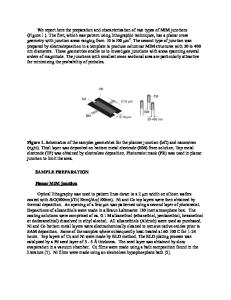Metal Complex Polymers for Electroluminescent Applications
- PDF / 317,356 Bytes
- 6 Pages / 414.72 x 648 pts Page_size
- 39 Downloads / 458 Views
ABSTRACT We report the synthesis and characterization of a soluble metal complex polymer for electroluminescent (EL) applications. The polymer was prepared by the reaction of a zinc Schiff base with 4,4'-diphenylmethane-diisocyanate. The polymer is amorphous and with glass transition temperature of 156 'C and is soluble in common organic solvents such as chloroform, tetrahydrofuran (THF), and N-methylpyrrolidinone (NMP). High optical quality films were obtained by spin-coating the polymer solution of THF. The zinc Schiff base, and the polyurethane (PU) shows strong photoluminescence under a UV-lamp illumination. Single and double layer EL devices consisting ITO/hole transfer layer (HTL)/PU/Al have been fabricated and characterized. The results indicated that the complex polymer could act as both electron transport and emissive layers for EL devices. INTRODUCTION There has been considerable recent interest in the use of organic materials, including vapor evaporated low-mass molecules and conjugated polymers, as electroluminescent layers in light emitting devices (LEDs) and large area displays[I-7]. The merits of organic materials for electroluminescent (EL) applications include high luminance and low drive voltage. Since the initial report of a multilayer LED based on vacuum-deposited low-mass metal complexes thin films of tris(8-hydroxyquinoline)-aluminum (A1Q3) [8,91, low-mass metal complexes have been widely used as emitter materials in EL devices. Compared to corresponding organic materials, metallic complexes have better mechanical strength and thermal stability, and a wide variety of central metal atoms, their size and oxidation states, as well as the size and nature of the ligands, provide architectural flexibility to tailor EL up to a maximum level. To date, however, metal complex polymers have not been extensively investigated for EL applications [4(a), 10]. We report here the synthesis and characterization of a metallic complex polyurethane (PU) which containing neutral metal complex of bis (N-salicylidene-p-2hydroxyethylphenylamino)zinc in the main chain, for EL applications. EXPERIMENT The synthesis of the monomers and polymer is shown in the following scheme. Nsalicylidene-p-2-hydroxyethylphenylamine (3) was obtained by the reaction of salicylaldehyde (1) with 4-aminophenethyl alcohol (2) in methanol at room temperature (yield 95%). The zinc coordination compound was obtained by the reaction of (3) with zinc acetate dihydrate Zn(COO)2. 2H20 in hot methanol using piperidine as catalyst (yield 86%). Preparation of polyurethane is carried out by treatment of zinc Schiff base with 4,4'-diphenylmethanediisocyanate in dimethyl-sulfoxide (DMSO) at 100 'C for 12 h, the metal complex 503
Mat. Res. Soc. Symp. Proc. Vol. 488 © 1998 Materials Research Society
polyurethane is precipitated in methanol and purified by washing with methanol. HO
\
-
&
NH2+
, \H OHC H+
MeO H .H \ & N -C R.T. HO / I HO HO 3 2 4-aminophenethyl alcohol (Salicylaldehyde) N-Salicylidene-p-2-hydroxyethyl phenylamine Yield 95% MeOH ZnO
Data Loading...











